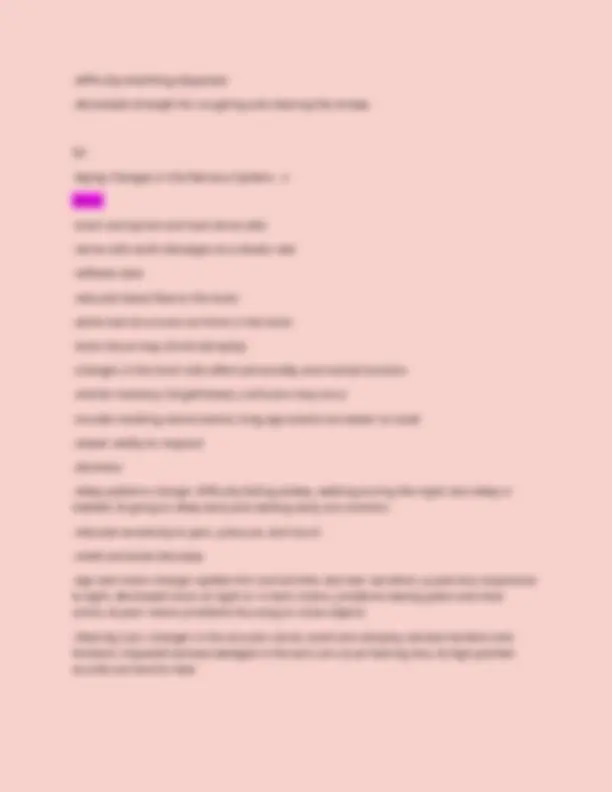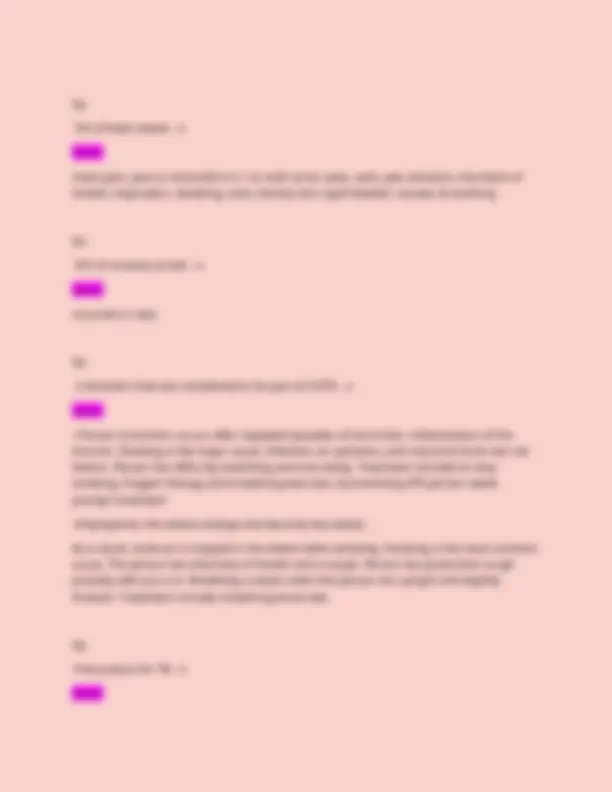





























































Study with the several resources on Docsity

Earn points by helping other students or get them with a premium plan


Prepare for your exams
Study with the several resources on Docsity

Earn points to download
Earn points by helping other students or get them with a premium plan
Community
Ask the community for help and clear up your study doubts
Discover the best universities in your country according to Docsity users
Free resources
Download our free guides on studying techniques, anxiety management strategies, and thesis advice from Docsity tutors
2023-2024 CNA STATE BOARD EXAM questions and answers with a+ graded Qs What position should a person with difficulty breathing be in? - n Ans✔ Fowler's position Qs Homeostasis - n Ans✔ A steady state Qs How many steps does an non-ambulatory person take when doing a transfer? - n Ans✔ 10 steps Qs What type of water do you put in a K-pad (aqua K pad)? - n Ans✔ Distilled water
Typology: Exams
1 / 67

This page cannot be seen from the preview
Don't miss anything!




























































Qs What position should a person with difficulty breathing be in? - n Ans✔ Fowler's position Qs Homeostasis - n Ans✔ A steady state Qs How many steps does an non-ambulatory person take when doing a transfer? - n Ans✔ 10 steps Qs What type of water do you put in a K-pad (aqua K pad)? - n Ans✔ Distilled water Qs How many ml's are in an ounce - n Ans✔
30 ml=1 oz Qs Which direction do you clean a catheter tube? - n Ans✔ clean downward away from the meatus, at least 4 inches of the catheter with one stroke Qs How do you transfer a person who has had a spinal injury? - n Ans✔ using a stretcher Qs How many people are needed to transfer a patient onto/off a stretcher? Where do the people stand? - n Ans✔ 2-3 staff members. 1-2 workers stand on the side of bed where the stretcher will be, while 1 worker stands on the side of the bed Qs When a personal is found lying in a urine soaked bed what can you be guilty of? - n Ans✔ neglect Qs How often should a person be repositioned? - n Ans✔
What side do you sit on to feed a person who has had a stroke? - n Ans✔ weak side or strong side Qs How often do you change linen? - n Ans✔ everyday when they become wet, soiled, or damped. In long term care, change on the person's bath or shower day-once or twice a week Qs Serous - n Ans✔ clear, watery drainage Qs Purulent - n Ans✔ thick yellow, brown, green drainage Qs Sanguineous - n Ans✔ bloody drainage Qs Serosanguineous - n
Qs What does an OT do? - n Ans✔ assists persons to learn or retain skills needed for daily living and working Qs What does an RT do? - n Ans✔ assists in treating lung and heart disorders. gives respiratory treatments and therapies. Qs 5 Rights of Delegation - n Ans✔ Right Task, Right Person, Right Supervision, Right Directions and Communication, and Right Circumstances Qs What should you know before performing a nursing task? - n Ans✔ if allowed by your state, in your job description, have necessary education and training, & nurse is available to supervise and answer your questions Qs What is OBRA and what does it regulate? - n Ans✔ Omnibus Budget Reconciliation Act of 1987 -a federal law in all 50 states
-its purpose is to improve the quality of life in nursing center residents -This law sets the minimum training and competency evaluation requirements for nursing assistants (NATCEP) -each state must have a NATCEP program -The nursing assistant training and competency evaluation program must be successfully completed by nursing assistants working in nursing centers, hospital long-term care units, and home care agencies receiving Medicare funds. Qs What does the Board of Nursing regulate? - n Ans✔ deny, revoke, or suspend a nurse's license to protect public from unsafe nurses Qs Informed Consent - n Ans✔ process by which a person receives and understands info about a treatment or procedure and is able to decide is he or she will receive it Qs Ethics - n Ans✔ knowledge of what is right and wrong conduct Qs Licensure - n Ans✔ required to operate and provide care
Qs Team Nursing - n Ans✔ a team of nursing staff led by the RN. The RN (team leader) delegates care based on person's needs and team members abilities Qs Primary Nursing - n Ans✔ RN is responsible for the person's total care. nursing teams assists as needed. Qs Case Management - n Ans✔ like primary nursing. RN coordinates person care from admission through discharge and into the home/long term care setting Qs Patient-focused care - n Ans✔ services are moved from the department to the beside. nursing team performs skills. Qs What is a CNA's role in the nursing process - n Ans✔ -Provide quality care -Protect the person's rights
-Provide for the person's and your own safety -Help keep the agency clean and safe -Act in a professional manner -Have good work ethics -Follow agency policies and procedures -Answer questions honestly and completely. Qs Ombudsman - n Ans✔ someone who supports or promotes the needs and interests of another person Qs What is considered to be involuntary seclusion? - n Ans✔ separating a person against his/her will Qs Patient Rights - n Ans✔ -Right to Information -Right to Refusing Treatment -Right to Privacy and Confidentiality -Right to Personal Choice -Right to Grievances -Right to Work -Right to Taking Part in Resident Groups
Qs What does OBRA require for certification - n Ans✔ background checks Qs Negligence - n Ans✔ unintentional wrong in which a person did not act in a reasonable/careful manner and a person or property was harmed Qs Malpractice - n Ans✔ negligence done by a professional person Qs HIPPA - n Ans✔ Health Insurance Portability and Accountability Act of 1996. -purpose is to protect the privacy and security of person's health information -gets power from the US gov Qs Nursing Assistant Role Limits - n Ans✔
never give drugs, never insert tubes or objects into body openings, do not remove tubes or object from body openings, never take oral or phone orders from doctor, and never tell person of family about diagnosis Qs Job Description - n Ans✔ describes what the agency expects you to do and states educational requirements and job title Qs Nursing Process - n Ans✔ method nurses use to plan and deliver nursing care. -Assessment: make observations -Nursing Diagnosis: RN uses assessment to make a nursing diagnosis -Planning: help patient meet goals. attend care conferences -Implementation: RN delegates tasks to CNA -Evaluation: report care and observations to RN -CNA's play a key role in assessment -CNA's make observations and give out care Qs Nursing Task - n Ans✔ nursing care or a nursing function, procedure, skill, or activity. Qs
Self-Esteem Needs - n Ans✔ make the person feel worthy and good enough about themselves Qs Self-Actualization Needs - n Ans✔ can be postponed and live will continue Qs Good Communication Device for a Person who is Deaf? - n Ans✔ Interpreter Qs Good Communication Device for a Person who is Confused? - n Ans✔ Hearing Aids Qs What is an open-ended question? - n Ans✔ a question that leads to a person to share their thoughts, ideas, and feelings. more than a "yes" or "no" answer Qs Objective Data - n
Ans✔ information that is seen, heard, felt, or smelled by an observer; signs Qs Subjective Data - n Ans✔ things a person tells you about that you cannot observe through your senses; symptoms Qs Care Plan - n Ans✔ written guide about the person's nursing care Qs What is the number one way to prevent any injuries? - n Ans✔ identifying risk factors Qs Aging-Changes in the Circulatory System - n Ans✔ -heart pumps with less force -heart valves thicken and become stiff -heart rate may slow -abnormal heart rhythms may occur -heart may enlarge slightly -heart walls thicken
-difficulty breathing (dyspnea) -decreased strength for coughing and clearing the airway Qs Aging-Changes in the Nervous System - n Ans✔ -brain and spinal cord lose nerve cells -nerve cells send messages at a slower rate -reflexes slow -reduced blood flow to the brain -abnormal structures can form in the brain -brain tissue may shrink (atrophy) -changes in the brain cells affect personality and mental function -shorter memory; forgetfulness; confusion may occur -trouble recalling recent events; long-ago events are easier to recall -slower ability to respond -dizziness -sleep patterns change: difficulty falling asleep, walking during the night, less sleep is needed, & going to sleep early and waking early are common -reduced sensitivity to pain, pressure, and touch -smell and taste decrease -eye and vision change: eyelids thin and wrinkle, less tear secretion, pupils less responsive to light, decreased vison at night or in dark rooms, problems seeing green and blue colors, & poor vision; problems focusing on close objects -Hearing Loss: changes in the acoustic nerve, eardrums atrophy, earwax hardens and thickens; impacted earwax (wedged in the ear) can cause hearing loss, & high-pitched sounds are hard to hear
Qs Aging-Changes in the Integumentary System - n Ans✔ -skin becomes less elastic -skin loses strength -brown spots (age spots or liver spots) on the wrists and hands -fewer nerve endings affect temperature, pressure, and pain sensation -fewer blood vessels -fatty tissue layer is lost -skin thins and sags -skin is fragile and easily injured or burned -fold, lines, and wrinkles appear -blood vessels become more fragile -decreased secretion of oil and sweat glands -dry, itchy skin -more sensitive to cold -nails become thick and tough -whitening or graying hair -facial hair in some women -loss or thinning of hair -drier hair Qs Aging-Changes in the Musclo-Skeletal System - n Ans✔ -muscle shrink (atrophy) -muscle strength, tone, and contractility decrease